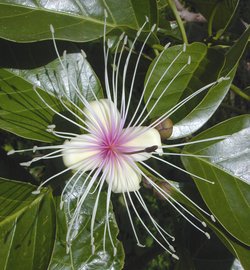Stamen
|
|
The stamen is the male organ of a flower. Each stamen generally bears four pollen-sacs (microsporangia) which are associated to form the anther, and carried on a stalk called the filament. The development of the microsporangia and the contained haploid spores (called pollen-grains) is closely comparable with that of the microsporangia in gymnosperms or heterosporous ferns. The pollen is set free by the opening (dehiscence) of the anther, generally by means of longitudinal slits, but sometimes by pores, as in the heath family (Ericaceae), or by valves, as in the barberry family. It is then dropped or carried by some external agent — wind, water or some member of the animal kingdom — on to the receptive surface of the carpel of the same or another flower.
Typical flowers have six stamens inside a perianth (the petals and sepals together), arranged in a whorl around the pistil. But in some species there are many more than six present in a flower (see, for example, the spider tree flower at right). Collectively, the stamens are called an androecium (from Greek andros oikia: man's house). They are positioned just below the gynoecium. The anthers are bilocular. i.e. they have two locules. Each locule contains a microsporangium. The tissue between the locules and the cells is called the connective.
In an immature, unopened bud, the filaments are still short. Their function is then to transport nutrients to the developing pollen. They start to lengthen once the bud opens. The anther can be attached to the filament in two ways:
- basifixed : attached at its base to the filament; this gives rise to a longitudinal dehiscence (opening along its length to release pollen).
- versatile : attached at its center to the filament; pollen is then released through pores (poricidal dehiscence).
Stamens can be connate (fused or joined in the same whorl) :
- monadelphous : fused into a single, compound structure
- diadelphous : joined partially tinto two androecial structures.
- synantherous : only the anthers are connate (such as in the Asteraceae)
Stamens can also be adnate (fused or joined from more than one whorl)
- epipetalous : adnate to the corolla.
- didynamous : occurring in two pairs of different length.
- tetradynamos : occurring as a set of six filaments with two shorter ones.
- exserted : extending beyonf the coralla.
- included : not extending from the coralla.
In the typical flower (that is, the majority of flowering plant species) each flower has both a pistil and stamens. The bisexual plants are called hermaphrodites or perfect flowers.
However, in some species the flowers are unisexual with only either male or female parts (monoecious = on the same plant; dioecious = on different plants). A flower with only male reproductive parts is called androecious. A flower with only female reproductive parts is called gynoecious.
A flower having only functional stamens is called a staminate flower.
An abortive or rudimentary stamen is called a staminodium, such as in Scrophularia nodosa.
The pistil and the stamens of orchids are fused into a column. The top part of the column is formed by the anther. This is covered by an anther cap
WheatFlower3.JPG
Amaryllis_stamens_aka.jpg
Daylily_Stamens_dry_01v2.jpg
es:Estambre
eo:Stameno
de:Staubblatt
fr:Étamine
nl:Meeldraad
pt:Androceu


